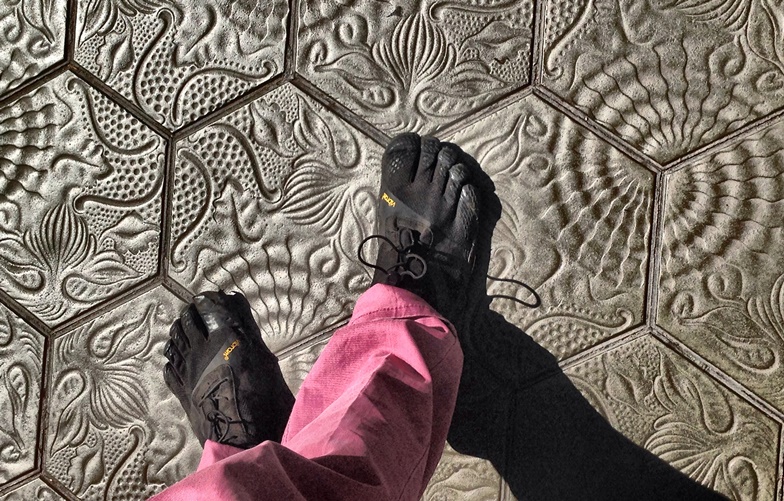As soon as I transitioned from conventional footwear to minimalism (footwear without arch support and heel cushioning) my arches were achy. This under-foot pain should be embraced because it means the arch along with the soft tissues that help support the arch are getting stronger. This is why the last thing you should do to alleviate the pain is revert to wearing arch-supportive footwear or thickly padded footwear because your arches will only get weaker.
The best thing you can do is continue with your minimalist journey. You must always remember that your feet will get stronger in minimalist shoes. They will even become stronger much quicker if you walk barefoot, especially outdoors on uneven surfaces.
Make Minimalism Your Plan to Gain Stronger Feet
Best Way to Strengthen Your Foot’s Arches
I became more confident about the health benefits of minimalism when I came across a study by Miller at el. 2014 which showed that runners feet are better able to improve in strength while wearing minimalist shoes on a daily basis.
Their study mentioned that humans walked and ran barefoot and in minimalist footwear throughout much of our evolution and that today’s modern athletic footwear is drastically different from that of our ancestors, suggesting that our feet have not yet evolved to run safely in footwear with ‘technology advancements’ and that our feet much prefer a more simplistic design of a shoe. This is why most runners get injured.
In addition, the researchers postulated that arch-supportive footwear with thick padding reduces workload from the feet, which is part of why these shoes interfere with the foot’s normal function, especially in the arch, which can hinder normal arch function and can lead to pain and injury when running. Overall, the foot is less resilient to stress, and the arch is more prone to collapsing.
The importance of minimalist footwear is that they reverse this intrinsic muscle weakness of the feet.
In their study, the researchers examined changes in foot strength in runners who transitioned from conventional running shoes to minimalist running shoes over a 12-week period. The researchers measured foot strength by quantifying the changes in intrinsic foot musculature volume. These runners were compared to a control group of runners –runners who habitually wear and wore conventional running shoes.
The runners in minimalist shoes showed exceptional improvements in foot strength, specifically in the toes and the metatarsal heads as well as gains in foot muscle volume as compared with the control group of runners. Based on their unsurprising data, the researchers concluded that runners who wear conventional running shoes will attain stronger feet and arches if they wear minimalist running shoes.
The researchers also revealed that the continuous use of minimalist footwear results in positive anatomical changes in the feet. These findings add a stronger scientific voice to the running community whereby strong feet are one of the most fundamental ways a runner can avoid injury because a stronger foot is better able to control unwanted movements of the rearfoot, even unwanted movements in the knee-joint.
Final Thoughts
Minimalism is one of the most fundamental ways a runner can avoid injury. Minimalist running has been an area of interest in biomechanical research as minimalist shoes can promote healthy, stronger feet in runners.
To obtain faster results, choose a ‘true’ minimalist shoe. Here, I list all the minimalist shoes I think best approximate the barefoot experience. And, it always helps to go for long walks barefoot (if you are afraid of running barefoot). The best part about walking barefoot vs running barefoot is that you cannot overdo it when you walk barefoot –trust me on this one.
More From Run Forefoot:
Best Barefoot Running Shoe Brands
Best Minimalist Running Sandals
Injuries Caused by Heel Strike Running
Why Land on the Outside of Your Forefoot
References:
Miller et al. The effect of minimal shoes on arch structure and intrinsic foot muscle strength. J Sport Health Sci, 2014, 3, 74-85.
Bretta Riches
BSc Neurobiology; MSc Biomechanics candidate, ultra minimalist runner & founder of RunForefoot. I was a heel striker, always injured. I was inspired by the great Tirunesh Dibaba to try forefoot running. Now, I'm injury free. This is why I launched Run Forefoot, to advocate the health & performance benefits of forefoot running and to raise awareness on the dangers of heel striking, because the world needs to know.
Latest posts by Bretta Riches (see all)
- Does Foot Strike Really Matter in Running? YES! - 17/04/2024
- Heel Lifts Increase Injury in Runners - 16/04/2024
- Are Minimalist Shoes Good for Seniors? YES! - 14/04/2024

